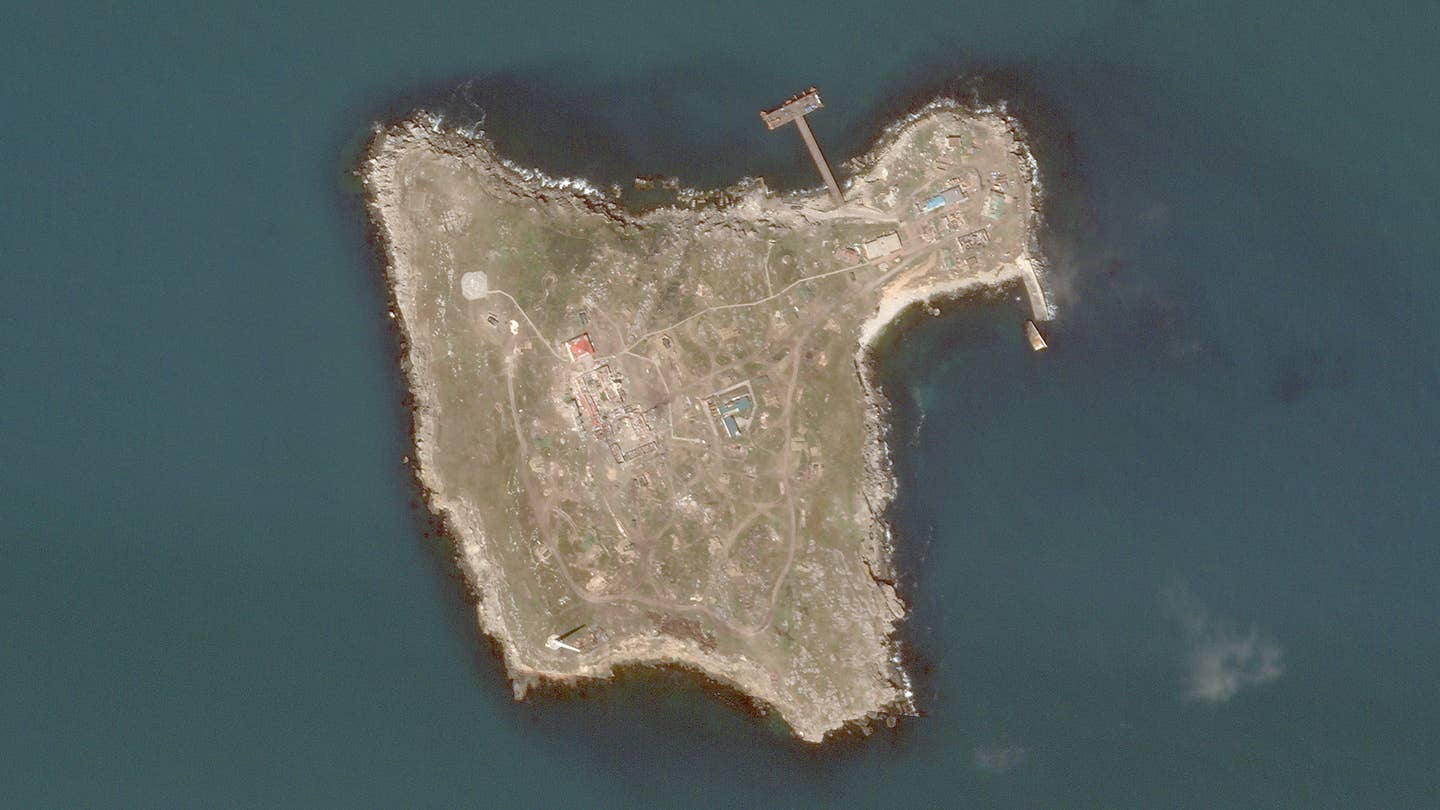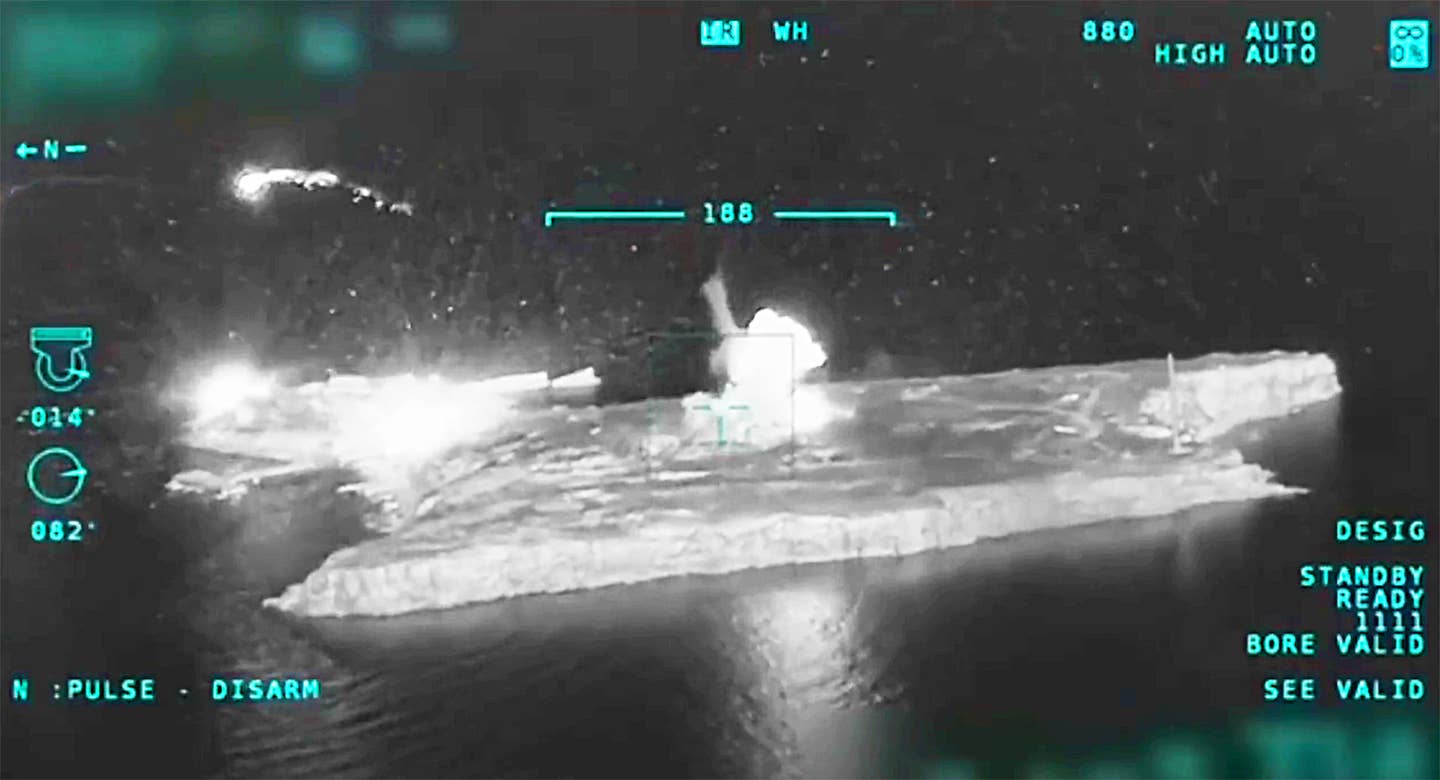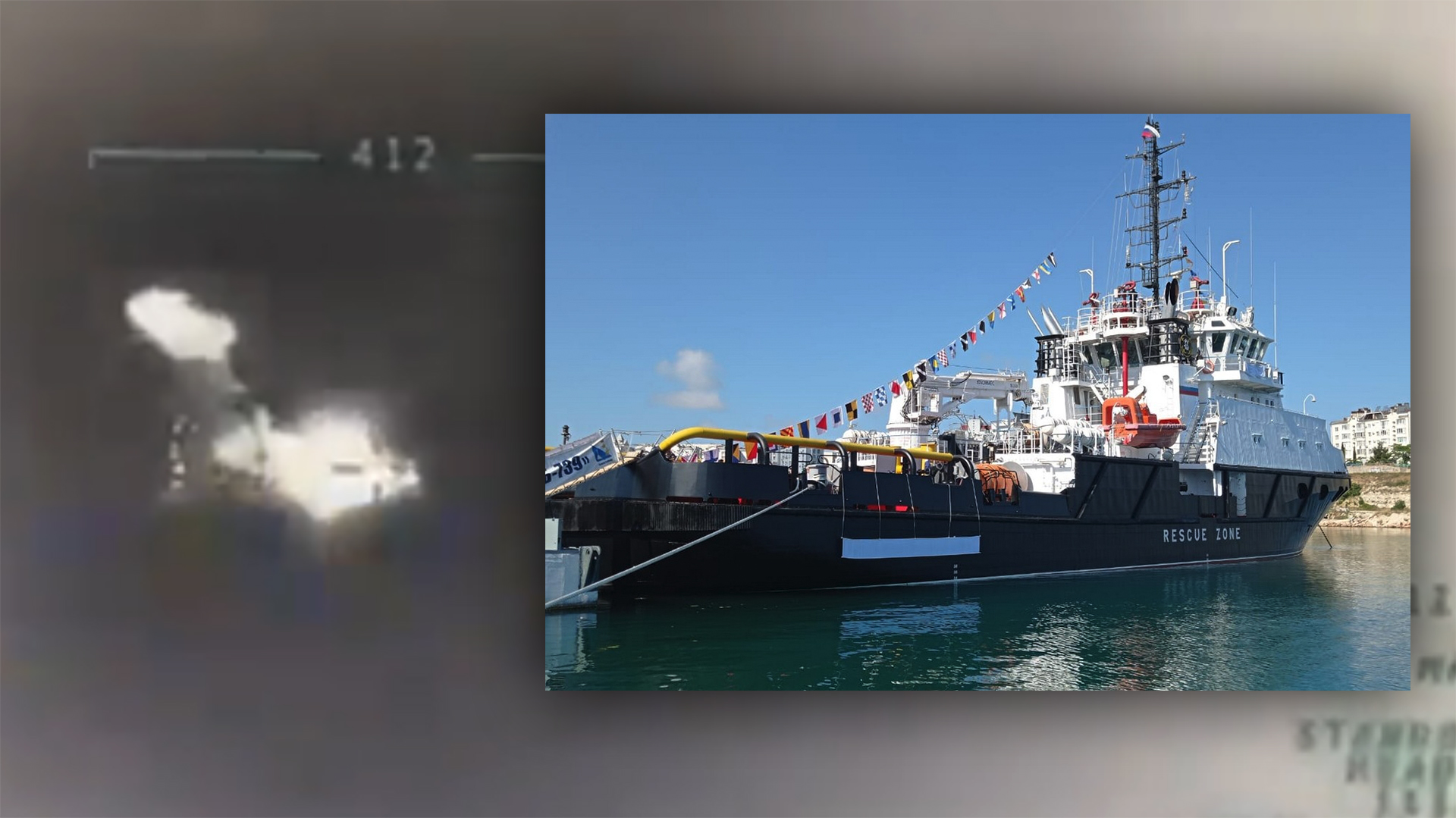The Ukrainian Navy claims to have struck another Russian vessel near the infamous Snake Island in the Black Sea, just over 20 miles off Ukraine’s southwest coast. The latest incident early this morning apparently involved a Russian rescue vessel, the Vasily Bekh, which was reportedly transporting personnel, weapons, and ammunition to the island, which has been occupied by Russian forces since very early in the conflict. Notably, Ukrainian officials claim that the ship was hit twice by Harpoon anti-ship missiles, which would represent the first successful combat use of the weapon in Ukrainian hands.
So far, there is little firm evidence of exactly what happened, although the Ukrainian Ministry of Defense has released footage taken from a Bayraktar TB2 drone that purportedly shows the engagement. The video appears to confirm that two separate missiles hit the ship.
That same video has been used to provide coordinates for the drone in question, placing it around 20 miles east of Snake Island.
The status of the vessel and its crew remain unknown. One unconfirmed Ukrainian account claims that “70% of the crew of the tugboat” was “affected,” by the attack, with the status of the remainder unknown. Similarly unconfirmed reports from Russia state that 10 out of the 33 crew have been posted missing with the remaining 23 injured. Normally, these vessels operate with a permanent crew of 26 sailors, plus up to 36 supporting crew.
Russian officials and state media, for their part, have not confirmed the incident and it remains possible the boat is still afloat and perhaps only damaged.
There are also reports from Ukraine that the Vasily Bekh was carrying a Tor-M2 series surface-to-air missile (SAM) system on board; these systems have been appearing with increasing regularity on Russian warships operating in the Black Sea and especially around Snake Island, as well as being deployed on the island itself.
Operated by the Russian Navy, the Vasily Bekh belongs to the Project 22870 class and is primarily a rescue tug, with a displacement of around 1,200 tons. With an overall length of 187 feet, this is one of six examples completed, with another reportedly under construction.
Typical duties of the Project 22870 include towing and helping refloat ships in trouble, diving operations, as well as naval firefighting and assorted utility work to assist both other vessels at sea and coastal infrastructure. Equipment is also provided to help with the evacuation of ship crews at sea.
Exactly what type of weapons were used to engage the Vasily Bekh cannot presently be verified. However, the video suggests that some type of anti-ship cruise missile was employed, and several Ukrainian officials have said that Harpoon missiles were involved. Retired Ukrainian Navy Capt. Andrii Ryzhenko, a former member of that nation’s General Staff, told The War Zone that the U.S.-made anti-ship missiles were used, echoing statements from Oleksiy Goncharenko, a member of the Ukrainian government, and from Maksym Marchenko, the governor of Odessa Oblast.
Notably, the transfer of ground-launched Harpoons to Ukraine, together with their all-important launchers, was only confirmed late last month. That has since been followed by a U.S. decision to supply more of the weapons, which you can read about here. Even without Harpoons, Ukraine has its own locally produced Neptune anti-ship missiles, although the number in hand before the war was thought to have been very small. There are also U.K.-supplied short-range Brimstones and, in the past, even used anti-armor weapons dropped by TB-2 drones have been used for attacking naval vessels.
Ukrainian and U.S. officials both attributed the successful Ukrainian attack on the cruiser Moskva, back in April, to Neptune missiles. The loss of that warship was seen as a major embarrassment and a significant loss of air defense and command and control capabilities in the Black Sea.
There is also the possibility that the Vasily Bekh was targeted using MAM-L munitions of the type that can be launched by the same TB2 drones, but that would not match the recorded video supposedly showing the engagement. In the past, Ukraine has used these munitions to engage smaller naval craft. Regardless, the video of the supposed strike taken from a TB2 would reinforce the claim that they are using the Turkish-made drones to initially find naval targets, and positively identify them, before sending anti-ship missiles their way. This was rumored to have been the case with the attack on Moskva, as well.
As for what the vessel was transporting to Snake Island, just last week we reported on how the outpost has been recently reinforced with additional SAM systems, which now include examples of both the Tor (SA-15 Gauntlet) and Pantsir (SA-22 Greyhound).

With that in mind, the Vasily Bekh could have been transporting another Tor system to the island or the example it was reportedly carrying may have been intended for organic defense. If that was the case, it appears to have failed to defeat an attack from the rear by whatever missiles were used to engage the boat.
The importance of Snake Island to Russian ambitions to control this critical part of the Black Sea — and its airspace — has long been clear. Early last month there was intense Ukrainian air activity near the island, with TB2 drones being used to attack air defense systems on the island and aboard nearby landing craft. Russian fast-attack boats in the waters near Snake Island also came under attack.
The Ukrainian Air Force has also used Su-27 Flanker fighter jets to engage Russian-occupied buildings on Snake Island, using unguided bombs in a daring low-level raid. You can read more about that attack here.

While we await further details on what happened today and the fate of the Vasily Bekh, it seems certain that the strategic Black Sea outpost retains a place in Russian war plans, at least for the time being. As we have explored in the past, Snake Island offers a platform for further air defense systems, potentially including S-400 SAMs, which could provide coverage deep into NATO territory and southern Ukraine. Long-range surveillance radars and other intelligence collection capabilities could be another useful addition.
Russia could potentially also use Snake Island as a platform for land-attack missiles, providing another vector for strikes against targets inside Ukraine and threatening NATO countries, as well. Even using it as a small forward arming and refueling point for interdiction operations into southwestern Ukraine, or even for combat search and rescue missions to support those operations, especially once HIMARS-launched guided rockets arrive in the country, is another possibility.
We will continue to update this story as more information becomes available.
Contact the author: joe@thedrive.com
